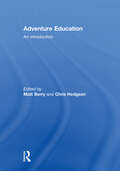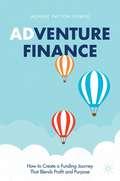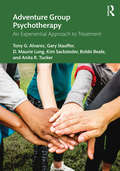- Table View
- List View
Adventure Carolinas
by Joe MillerHave you ever wanted to take up a new outdoor sport but thought, "Not me" or "Where do I begin"? In this unique take-it-with-you guide, outdoors and fitness writer Joe Miller introduces you to sixteen adventure sports in the Carolinas, from water to land and through all four seasons. No matter where you live or what your level of expertise may be, he will lead you to opportunities that range from beginner level to peak experience and equip you with the tools and courage to get outdoors and enjoy nature in new and exciting ways. For each experience, Miller includes location, how to start, associated costs, organizations that can help you begin, physical and mental demands of each activity, and whether the activities are seasonal or competitive.Activities include mountain biking, flat-water and whitewater paddling, scuba diving, climbing, backcountry exploration, skiing, snowboarding and tubing, kiteboarding, hang gliding, and ziplining.
Adventure Cats: Living Nine Lives to the Fullest
by Laura J. MossJust when you thought you knew all there was to know about cats comes the ultimate—and unexpected—guide to taking your cat into the wild. Here are cats walking on a leash. Cats hiking on a leash. Cats tramping through snow. Cats camping. Cats kayaking, canoeing, even surfing—yes, cats who love water. When animal writer and active hiker Laura Moss couldn’t find an online resource for hitting the trail with her cat, she created one. AdventureCats.org took off like wildfire, with attention from Wired, the Huffington Post, Outside magazine, BuzzFeed, and much more. Now, the book Adventure Cats—a collection of jaw-dropping photographs, inspiring stories of real-life cats, and all the how-to a cat owner needs—will take readers and their cats well beyond the backyard. Learn how to leash-train a cat. What to do if you encounter wildlife on the trail. Plus, winter safety tips, and how to bring a little bit of the outdoors to an indoor cat. The stories themselves are catnip for animal lovers, from Nanakuli, the one-eyed cat who hangs ten; to Georgie, a four-year-old gray tabby who lives on a sailboat; to Quandary, who not only insists on hiking with her family but also teaches them a valuable lesson: When you follow your cat’s natural tendency to wander, you experience the outdoors at a slower, richer pace. This book will delight every cat person, regardless of whether their pet is inclined to adventure. (Take the quiz at the beginning of the book to find out!)
Adventure Comics and Youth Cultures in India
by Raminder Kaur Saif EqbalThis pioneering book presents a history and ethnography of adventure comic books for young people in India with a particular focus on vernacular superheroism. It chronicles popular and youth culture in the subcontinent from the mid-twentieth century to the contemporary era dominated by creative audio-video-digital outlets. The authors highlight early precedents in adventures set by the avuncular detective Chacha Chaudhary with his ‘faster than a computer brain’, the forays of the film veteran Amitabh Bachchan’s superheroic alter ego called Supremo, the Protectors of Earth and Mankind (P.O.E.M.), along with the exploits of key comic book characters, such as Nagraj, Super Commando Dhruv, Parmanu, Doga, Shakti and Chandika. The book considers how pulp literature, western comics, television programmes, technological developments and major space ventures sparked a thirst for extraterrestrial action and how these laid the grounds for vernacular ventures in the Indian superhero comics genre. It contains descriptions, textual and contextual analyses, excerpts of interviews with comic book creators, producers, retailers and distributers, together with the views, dreams and fantasies of young readers of adventure comics. These narratives touch upon special powers, super-intelligence, phenomenal technologies, justice, vengeance, geopolitics, romance, sex and the amazing potentials of masked identities enabled by navigation of the internet. With its lucid style and rich illustrations, this book will be essential reading for scholars and researchers of popular and visual cultures, comics studies, literature, media and cultural studies, social anthropology and sociology, and South Asian studies.
Adventure Diffusion: From Meandering Molecules to the Spreading of Plants, Humans, and Ideas
by Gero VoglThis easy-to read book looks at the many ways in which diffusion bears on processes that involve dispersion, starting from the Brownian motion of molecules, covering the invasion of exotic plants, migration of populations, epidemics, and extending to the spreading of languages and ideas. Recently, there has been a growing interest in understanding migrations, diffusion and spreading outside the “hard” natural sciences of physics and chemistry, for example the spreading of plants introduced as a result of globalization. Another fascinating story is that of human migration in the distant past, i.e. the immigration of our ancestors who brought agriculture from the Near East, or the fast spread of the Palaeo-Indians into the Americas after the end of the Ice Age. Likewise, the spread of languages in the past, and even more so the current spread and retreat of languages will be described here in terms of diffusion. By understanding these principles, there is hope that some of the less common languages that are threatened by globalization can be saved. Another important implication discussed by the author concerns the outbreak of epidemics; these may be mitigated if we understand their spreading mechanism. Last but not least the spreading of ideas and innovations, a process which changes the world sometimes faster than we wish, can also be usefully described in this picture.
Adventure Divas: Searching the Globe for Women Who Are Changing the World
by Holly MorrisAfter years of working behind a desk, Holly Morris had finally had enough. So she quit her job and set out to prove that adventure is not just a vacation style but a philosophy of living and to find like-minded, risk-taking women around the globe. With modest backing, a small television crew, her spirited producer-mother, Jeannie, and a whole lot of chutzpah, Morris tracked down artists, activists, and politicos-women of action who are changing the rules and sometimes the world around them. In these pages, Morris brings to life the remarkable people and places she's encountered on the road while filming her PBS series Adventure Divas and other programs. We meet Assata Shakur, a former Black Panther and social activist and now a fugitive living in exile in Cuba; Kiran Bedi, New Delhi's chief of police, who revolutionized India's infamously brutal Tijar Jail with her humanitarian ethic; New Zealand pop star Hinewehi Mohi, a Maori who reinvigorates her native culture for a new generation; and Mokarrameh Ghanbari, a septuagenarian painter and rice farmer who lives in the tiny village of Darikandeh on the Caspian plains of Iran, where her creative talents run counter to the government's strict stance on art. Along the way, Morris herself becomes a certified Adventure Diva, as she hunts for wild boar with Penan tribesmen in the jungles of Borneo, climbs the Matterhorn short-roped to a salty fourth-generation Swiss guide, and memorably becomes the first woman ever to enter the traditional camel race of the Saharan oasis town of Timia. Intelligent, phenomenally funny, and chock-full of rich and telling details of place, Adventure Divas is a pro-woman chronicle for the twenty-first century. In a pilgrimage fueled by curiosity, ideology, and full-on estrogen power, Holly Morris has paved the way for all of us to discover our own diva within and set out on our own adventures.
Adventure Dogs: Activities to Share with Your Dog - from Comfy Couches to Mountain Tops
by Fern WattLet your dog lead the way to adventure!Grab your four-legged best friend and start making the most of every day, and every dog year. In Adventure Dogs: Activities to Share with Your Dog—from Comfy Couches to Mountain Tops, author Fern Watt teams up with canine experts to offer more than 50 surprising new ways to strengthen the connection you share with your dog. Captured in vibrant, full-color photography, activities range from simple to epic. What would make your dog's "bucket list" of must-see and -do adventures? Find out together as you uncover your pup's special interests and skills using this adventure book.Follow your pup into a world of herding, sniffing, playing, howling, and walking! From hiking a mountain or taking a smell walk in your own neighborhood to training like a Navy SEAL or practicing "doga" poses, Adventure Dogs has an activity or experience for every breed, personality, energy level, age, and dog parent. Our Dogs remind us that great adventures don't always require a passport—there are tons of wonders right outside our front doors.Perfect for dog lovers, armchair travelers, and active pet parents alike, Adventure Dogs reveals inspirational and practical ways for us humans to understand, appreciate, and live in the moment with our furry companions.• PRACTICAL ADVENTURES: Features more than 50 real, everyday activities to engage with your dog in scientifically-backed ways. With a range of prices, activity levels, and time investments, there's something in this animal activity book for everyone and every pup.• BACKED BY RESEARCH: Author Fern Watt traveled and did her own research with her rescue dog, Bette. She's also consulted renowned scientists and behaviorists (Alexandra Horowitz), bestselling dog-book authors (Seth Casteel), Instagram-famous dog owners (@tunameltsmyheart), and people who have expanded the limits of what we thought dogs could do, whether it's surf, skateboard, paint, do yoga, run for mayor, or graduate from an Ivy League school.• INSPIRATIONAL LOCATIONS: Features pet-friendly destinations (hotels, beaches, dog parks, hikes, and more!) around the United States and abroad.• OVERFLOWING WITH IDEAS: Watt consults a range of experts to add stories, tips, and photography to the book. The result is a vibrant collection of voices and perspectives.
Adventure Duck vs Power Pug: Book 1 (Adventure Duck)
by Steve ColeThere's no ducking out - it's time for this ordinary, wise-quacking duck to become . . . A Hero!Adventure Duck didn't ask for greatness. All he wanted was his nest on the duckpond and plenty of soggy bread to eat. But when a meteor gives him superpowers, he knows he must fly into battle and defeat the forces of evil.Every superhero needs a nemesis, and Adventure Duck finds a pint-sized one in Power Pug. This tiny arch-villain is plotting to take over the world with his hypnotic stare and an army of hench-animals. Luckily, Adventure Duck has helpers, too. There's Yoki - a mystical, moustachioed egg - and Neon Zebra, Adventure Duck's karate-kicking sidekick.Can Adventure Duck and his friends stop Power Pug in this egg-ceptionally funny, action-packed adventure?
Adventure Duck vs The Wicked Walrus: Book 3 (Adventure Duck)
by Steve ColeThere's no ducking out - the space race is on and Adventure Duck must defeat his new nemesis, the Wicked Walrus!Adventure Duck fluffs up his feathers and heads to the North Pole, where his ice-hearted enemy, Power Pug, has set up a secret space base. The pug's latest hench-animal, a super-smart walrus, is building a rocket to blast his master to Mars. But if it launches, the whole Artic will be wiped out! Can Adventure Duck and his new friend - an (occasionally) invisible reindeer - stop Power Pug from expanding his evil empire in outer space?
Adventure Duck vs the Armadillo Army: Book 2 (Adventure Duck)
by Steve ColeThe duck with the supersonic quack is back! Adventure Duck, the world's unlikeliest superhero, has a tasty new mission - saving the world from DEATH BY CHOCOLATE!Ay, caramba! Adventure Duck and his zebra sidekick, Ziggy, have a tasty new mission in Mexico. Their nemesis, Power Pug, has a dastardly new scheme to control the world's chocolate supply. With the help of a llama with projectile spit, Adventure Duck and Ziggy set out to foil the pug's nefarious plans to dig up the rainforest to build an enormous chocolate factory. But Armando the Commando and his army of armadillos stands in their way... Can the superhero amigos find a chink in the armadillos' armour and save the world from DEATH BY CHOCOLATE?
Adventure Education: An Introduction
by Matt Berry and Chris HodgsonAdventure Education is a form of experiential learning typically associated with activities involving risk, from cooperative games such as raft building to high adventure activities such as rock climbing. Adventure Education: An Introduction provides a comprehensive introduction to the planning, delivery and evaluation of Adventure Education, with a strong emphasis on professional practice and delivery. Written by a team of leading Adventure Educators who can draw upon an extensive experience base, the book explores the most important strategies for teaching, learning and implementation in Adventure Education. The book is fully illustrated throughout with real-world case studies and research surveying the key contemporary issues facing Adventure Education Practitioners. This includes essentials for the adventure educator such as risk management and tailoring activities to meet specific learning needs, as well as providing an insight into contemporary uses for adventure programmes. With outdoor and adventure activities being more popular than ever before, this book is essential reading for any student, teacher or practitioner looking to understand Adventure Education and develop their professional skills.
Adventure Education: Fun games and activities for children and young people
by Linda RitsonThis essential guide promotes learning through activity-centred adventure experiences, providing skill development, social education and personal development for practitioners, teachers, support staff and youth groups. This book offers advice and practical guidance on planning, setting up and running adventure education sessions with children and young people. Divided into two parts, it gives an overview of adventure education, explaining how it relates to holistic and outdoor learning and how it encourages active engagement from the learners as well as the instructors. Adventure Education provides a toolkit of various games and activities that can be used with groups of young children, including parachute games, card and musical activities, and climbing and traversing games. This book will be essential reading for all Early Years practitioners, Primary teachers and support staff wanting to develop their skills and deliver adventure learning effectively, as well as youth groups looking to provide informal learning as well as physical opportunities.
Adventure Education: Theory and Applications
by Dick Prouty Jane Panicucci Rufus CollinsonAdventure Education: Theory and Applicationsallows students to -get a broad view of adventure education and programming; -explore the role of games, low- and high-element courses, and outdoor pursuits in adventure education; -use key concepts, student activities, and Web-based research to enhance the learning process; -employ real-world examples to explore strategies for adventure education in a variety of settings; and -learn core skills for effective facilitation and leadership preparation in adventure programming. With Adventure Education: Theory and Applications, adventure education enters the educational mainstream. This comprehensive text is ideal for introductory adventure courses in a variety of college departments and as a reference for professionals in the field. Project Adventure, a leader in the field of facilities-based adventure learning, teams up with leading adventure educators and professionals to provide a broad view of adventure education and programming. Together, they present the foundational theories and applications of adventure education. In doing so, they -explore the role of games, low- and high-element courses, and outdoor pursuits in adventure education; -cover the core skills for effective facilitation and leadership preparation; -include student-friendly features, such as key concepts, summaries, student activities, additional readings, and Web-based research to meet students' levels of experience and enhance the easy delivery of the course; and -recommend strategies for adventure education and programming based on real-world examples that connect to a variety of recreational, educational, therapeutic, and community settings. Part Ipresents the history of adventure education as well as the numerous theories and philosophies that have informed its development. It explores the world of adventure in education, health care, and therapeutic, corporate, and school settings. It also provides an overview of adventure organizations and career options, which is helpful to students who are interested in pursuing the study of adventure. Part IIoutlines the technical and pedagogical skills needed for facilitating adventure experiences. Part IIIdescribes each adventure component, explaining how they work in the educational process. It covers facilities-based pursuits such as games, cooperative activities and initiatives, and challenge courses as well as outdoor pursuits. Some sample activities and many additional resources are provided. The final chapter covers models for programming adventure in educational, therapeutic, corporate, and community settings. For students who select careers in other fields, the leadership and team skills learned through Adventure Education: Theory and Applicationswill serve them well in their future workplaces. For students who do go into adventure education, this text is their guide for finding their own paths in the field.
Adventure Finance: How to Create a Funding Journey That Blends Profit and Purpose
by Aunnie Patton PowerThe venture capital model doesn’t work—at least not for 99% of startups and small businesses. In this 99% are a lot of companies with incredible potential: businesses headed by female founders and those from diverse racial backgrounds, organizations headquartered outside of venture capital hubs, and purpose-driven enterprises that are creating social and environmental impact alongside financial success. Counter to what the press-savvy venture capital world would have you believe, there are a lot of funding options out there for startups and small businesses. Adventure Finance is designed to help you understand some of these options, and walk you through real examples of how other founders and funders have put them to use. In simple, approachable language, the book breaks down the different types of funding options available from revenue-based financing to recoverable grants to redeemable equity to distributed ownership and more. Through a mix of storytelling and frameworks, based on a decade of research and experience in investing in early-stage companies, this book will give you the ability to determine how each of these structures can contribute to your own funding journey. The goal for this book is to shift the conversation about startup funding and help founders and funders widen the spectrum of “mainstream” investment options in order to make the venture financing world more inclusive and purpose-driven.
Adventure Fire: Adventures of Dusty Sourdough, Book 4
by Glen GuyOut of habit Dusty checked his Winchester to make sure a round was in the chamber, and then eased himself forward, keeping out of view of the front window. It was obvious to Dusty, because of the ruckus Little Bear was causing on the porch, that whoever was inside--if anybody--was forewarned, so the element of surprise was not in Dusty's favor. With these thoughts in mind, Dusty said to no one in particular, "Oh well," and he leaped to the porch, with his rifle at the ready. In an instant he was through the partially open door, ready for whatever consequence awaited him inside.
Adventure For Alison
by Elizabeth HowardAfter running away from their guardians to search for their older brother, Hugh, Alison and her twin, Gavin, find themselves aboard the Caroline, heading toward the colonies. They have heard that Hugh, because of his loyalty to the Stuart cause, has had to take refuge somewhere in the new world and they are determined to find him. It is not until they reach Boston that they realize they are to be sold as bond servants. Gavin is apprenticed to a bookseller and Alison is obliged to fit herself into the role of lady's maid to the spoiled Henrietta. Her life is no longer as carefree and easy as it was in Scotland, but her duties are not too difficult. After escorting Henrietta to Mrs. Bassett's school for young ladies she frequently has time to stop at the bookseller's shop to discuss plans with Gavin for finding their brother. On one occasion, while on an errand that leads her through Old Boston's narrow, winding streets, to her great dismay, Alison suddenly recognizes a familiar profile and she and Gavin are once more faced with the possibility of having to run away. Elizabeth Howard has chosen Old Boston with its busy streets and ship filled harbor for the background for this pre-revolutionary story and again she has created some convincing characters and an excellent plot. Ages 12-16
Adventure Girls! STEM Crafts: 40 Activities for Curious, Creative, Courageous Girls (Adventure Crafts for Kids)
by Dr. Megan Olivia Hall PhD, MEdInspire girls to build and create with fun, hands-on STEM crafts for ages 6 to 12 The world needs adventurous girls to lead the way to a brighter future! Help them discover new things about science, technology, engineering, and math (STEM) with this collection of engaging crafts for girls. As they learn and have fun with each project, they'll boost their critical-thinking skills, creativity, and self-confidence, too. What sets this book of STEM crafts apart: No parents required!—Encourage independence with arts & crafts that can be made with basic household materials and include kid-friendly, step-by-step instructions. Skill-building projects—Every project, from creating a Newton's cradle to knitting a DNA garland, incorporates basic STEM principles to help curious girls learn more about the world around them. Adventure girl challenges—Bonus activities and fun facts sprinkled throughout the book will inspire girls to dive deeper into the concepts and skills they're learning. Help girls have a blast discovering the secrets of the STEM universe through educational crafts for kids.
Adventure Girls!: Crafts and Activities for Curious, Creative, Courageous Girls (Adventure Crafts for Kids)
by Nicole DugganExplore, create, and imagine like a girl!Girls can do anything, and Adventure Girls! proves it! Packed with exciting activities and crafts for girls (ages 6 to 12), this book inspires young adventurers to be curious, innovative, and bold. From stargazing and animal tracking to making a pinhole camera and building a shadow theater, Adventure Girls! is not one of your typical craft books. It empowers girls to:Develop independence—Many of the activities are designed to be parent-assisted as girls learn to explore and create safely on their own.Delve into science—Discover scientific ideas and principles through constellation identification, bird watching, and compass making.Get their hands dirty—Adventure Girls! encourages outdoor play and exploration, from making a rope swing in the backyard to going on a nature scavenger hunt to building a shelter outside.Express their creative side—These crafts for girls also engage their artistic side, with activities like creating decorative 3D stars, pressing flowers, and folding (and inventing their own) paper airplanes.Instill confidence and curiosity with this collection of fun, engaging activities and crafts for girls.
Adventure Gold: Adventures of Dusty Sourdough, Book 3
by Glen GuyThe current was pulling at Dusty's legs. It was a sucking feeling and he knew that it was about to pull him under. There wasn't a thing he could do to stop it. The cold was numbing and his arms felt like lead. He struggled for one last deep breath as the surging water pulled him down. Down into what he thought would be his watery grave.
Adventure Group Psychotherapy: An Experiential Approach to Treatment
by Tony G. Alvarez Gary Stauffer D. Maurie Lung Kim Sacksteder Bobbi Beale Anita R. TuckerAdventure Group Psychotherapy: An Experiential Approach to Treatment explores what is necessary for an experiential therapy group to function effectively, and the practical skills needed to inspire success. The authors describe how to use activities in a manner that produces the greatest opportunity for clients to reach their goals. Issues such as how to actively assess client functioning in the group, how to select the appropriate activity, how to shape an effective environment, and how to help clients process their experience are a few of the aspects examined to help clients move toward their goals. The practical skills the authors describe enable readers to immediately learn and apply their practice with groups. This book will be an important tool in any group therapy class, in practice settings to train practitioners, and for any clinician trying to expand their group work capabilities.
Adventure In Bear Tooth Mountains
by Johnnie Tuitel Sharon E. Lamson<P>A three-family Christmas holiday promises hours of skiing, hiking and relaxing in the scenic Bear Tooth Mountains of Montana. At Eagle Mount, Johnnie learns how people with disabilities can snow ski and enjoy other activities. <P>But this isn't the only discovery he and his friends make. An abandoned shack near a deserted ghost town, a snowmobile chase and a blizzard provide a chilling adventures that tests the childrens' courage and survival skills.
Adventure In City: Volume 1 (Volume 1 #1)
by Ma XiaoHuI never thought I'd go to the nightclub! And also entered this line! The year he graduated, he was dumped by his girlfriend, humiliated by the rich and handsome, he lost his job, and his life was at rock bottom …Unintentionally passing by a KTV, attracted by the high recruitment notice …And from then on, I embarked on a life that I had never imagined …
Adventure In City: Volume 10 (Volume 10 #10)
by Ma XiaoHuI never thought I'd go to the nightclub! And also entered this line! The year he graduated, he was dumped by his girlfriend, humiliated by the rich and handsome, he lost his job, and his life was at rock bottom …Unintentionally passing by a KTV, attracted by the high recruitment notice …And from then on, I embarked on a life that I had never imagined …
Adventure In City: Volume 2 (Volume 2 #2)
by Ma XiaoHuI never thought I'd go to the nightclub! And also entered this line! The year he graduated, he was dumped by his girlfriend, humiliated by the rich and handsome, he lost his job, and his life was at rock bottom …Unintentionally passing by a KTV, attracted by the high recruitment notice …And from then on, I embarked on a life that I had never imagined …
Adventure In City: Volume 3 (Volume 3 #3)
by Ma XiaoHuI never thought I'd go to the nightclub! And also entered this line! The year he graduated, he was dumped by his girlfriend, humiliated by the rich and handsome, he lost his job, and his life was at rock bottom …Unintentionally passing by a KTV, attracted by the high recruitment notice …And from then on, I embarked on a life that I had never imagined …
Adventure In City: Volume 4 (Volume 4 #4)
by Ma XiaoHuI never thought I'd go to the nightclub! And also entered this line! The year he graduated, he was dumped by his girlfriend, humiliated by the rich and handsome, he lost his job, and his life was at rock bottom …Unintentionally passing by a KTV, attracted by the high recruitment notice …And from then on, I embarked on a life that I had never imagined …




















